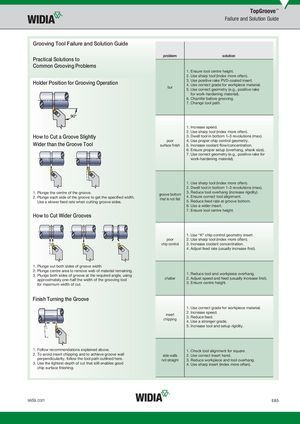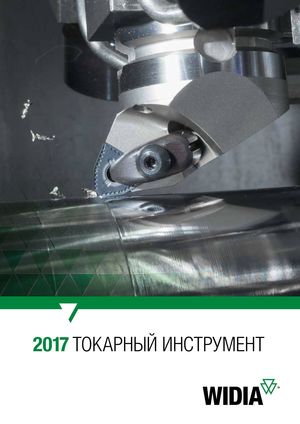Общий каталог Widia 2017 - страница 549
Навигация
- Table of Contents
- Turning
- Turning • ISO Inserts
- Turning • Tools for External Turning and Internal Boring
- Turning • Tools for External Turning and Internal Boring
- Turning • Tools for Small Hole Boring
- com E1Turning • Grooving and Cut-Off
- Turning • Threading
- Indexable Milling
- Indexable Milling • Face Mills
- Indexable Milling • Chamfer Mills
- Indexable Milling • 90° Shoulder Mills
- Indexable Milling • Helical Mills
- Indexable Milling • Slotting Mills
- Indexable Milling • Copy Mills
- Solid End Milling
- Solid End Milling • High-Performance Solid Carbide End Mills
- Solid End Milling • General Purpose Solid Carbide End Mills
- Solid End Milling • High-Performance High-Speed Steel (HSS-E/PM)
- Solid End Milling • Burs
- Holemaking
- Holemaking • High-Performance Solid Carbide Drills
- Holemaking • Modular Drills
- Holemaking • Indexable Drills
- Holemaking • Modular Drills
- Holemaking • Indexable Drills
- Holemaking • Hole Finishing
- Tapping
- Tapping Portfolio
- Index by Order Number
- Index by Catalogue Number
- Global Contacts
- Informational Icons Guide
- Material Overview • DIN

TopGroove™ Failure and Solution Guide Grooving Tool Failure and Solution Guide problem solution Practical Solutions to Common Grooving Problems 1. Ensure tool centre height. 2. Use sharp tool (index more often). Holder Position for Grooving Operation 3. Use positive rake PVD-coated insert.bur4. Use correct grade for workpiece material.5. Use correct geometry (e.g., positive rake for work-hardening material). 6. Chamfer before grooving. 7. Change tool path. 1. Increase speed. 2. Use sharp tool (index more often). How to Cut a Groove Slightly 3. Dwell tool in bottom 1–3 revolutions (max). poor 4. Use proper chip control geometry. Wider than the Groove Tool surface finish 5. Increase coolant flow/concentration. 6. Ensure proper setup (overhang, shank size). 7. Use correct geometry (e.g., positive rake for work-hardening material). 1. Use sharp tool (index more often). 2. Dwell tool in bottom 1–3 revolutions (max). 1. Plunge the centre of the groove.2. Plunge each side of the groove to get the specified width.Use a slower feed rate when cutting groove sides.groove bottomthat is not flat3. Reduce tool overhang (increase rigidity).4. Ensure correct tool alignment.5. Reduce feed rate at groove bottom. 6. Use a wider insert. 7. Ensure tool centre height. How to Cut Wider Grooves 1. Use “K” chip control geometry insert. poor 2. Use sharp tool (index more often). chip control 3. Increase coolant concentration. 4. Adjust feed rate (usually increase first). 1. Plunge out both sides of groove width. 2. Plunge centre area to remove web of material remaining. 3. Plunge both sides of groove at the required angle, using 1. Reduce tool and workpiece overhang. approximately one-half the width of the grooving tool chatter 2. Adjust speed and feed (usually increase first). for maximum width of cut. 3. Ensure centre height. Finish Turning the Groove 1. Use correct grade for workpiece material. insertchipping 2. Increase speed.3. Reduce feed.4. Use a stronger grade. 5. Increase tool and setup rigidity. 1. Follow recommendations explained above. 1. Check tool alignment for square. 2. To avoid insert chipping and to achieve groove wall side walls 2. Use correct insert hand. perpendicularity, follow the tool path outlined here. not straight 3. Reduce workpiece and tool overhang. 3. Use the lightest depth of cut that still enables good 4. Use sharp insert (index more often). chip surface finishing. widia.com E85
 Каталог Widia токарный инструмент 2017
Каталог Widia токарный инструмент 2017 Каталог Widia трохоидальное фрезерование
Каталог Widia трохоидальное фрезерование Каталог Widia техническое руководство по разверткам
Каталог Widia техническое руководство по разверткам Каталог Widia фрезы со сменными пластинами 2016
Каталог Widia фрезы со сменными пластинами 2016 Каталог Widia достижения 2020
Каталог Widia достижения 2020